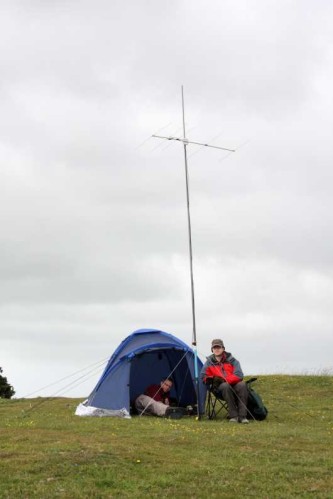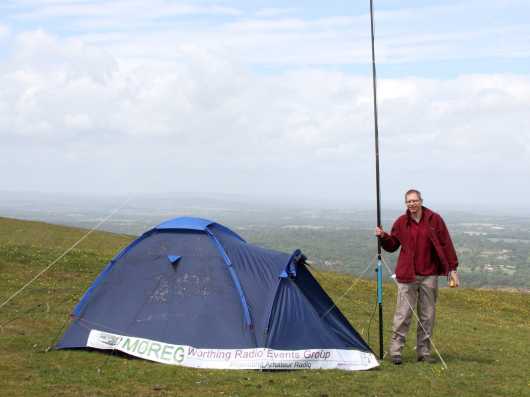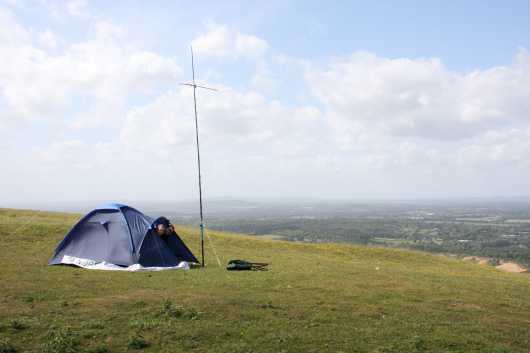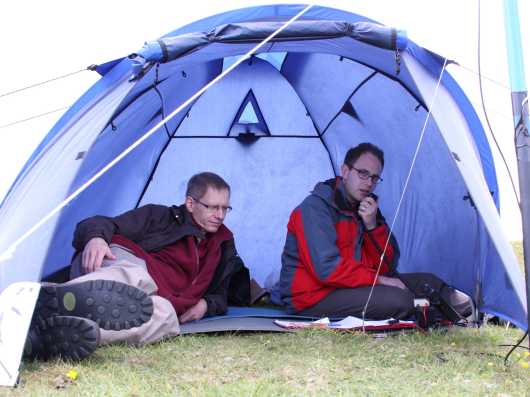The day dawned bright and windy with the forecast of rain at lunchtime, just in time for the start of the 4-hour contest. Gary G0XAN, Peter M0PCR and David M0HVD set off from the car park just outside Washington village for the 20-minute walk to Chanctonbury Ring at the top of the South Downs. It was warm but windy in the valley and would surely only be windier on the ridge.
On the ridge it was very windy indeed and the decision was taken to pitch the tent first, then set the antenna mast up as close to the tent as possible. The rain clouds were already beginning to gather on the horizon. Whilst it is possible to pitch the tent single-handed, having three pairs of hands made it much more manageable in the wind. All possible guys were deployed and the tent was still bending significantly in the stronger gusts.

The ultra-light portable 5-element beam was assembled and set up on the 4m mast. With guys at the top and bottom of the mast it was stable even in the strongest of gusts. The “Armstrong” rotator seemed to be working well. With 20 minutes to spare before the start of the contest we had a quick tune around the band to gauge conditions. There were several strong stations audible in the parallel 144MHz May contest, but conditions seemed average at best. Then it was time for some lunch before our contest began.

The contest started quite well, tuning up & down the band we managed to find several stations taking part in the main contest who were glad of an answer to their CQ call. We even gave some a new multiplier (BN postcode).
Whilst tuning across the band we heard a faint station and part of an unusual callsign. “...D8E...” was definitely worth investigating... It turned out to be GD8EXI on the Isle of Man; it took some considerable effort but we made the contact and scored 462 points and three multipliers (square, country and postcode) so it was worth the perseverance.

After a reasonable first hour, our contact rate went right down in the second hour. This seemed to coincide with some heavy rain showers passing over which made hearing the stations we could find rather difficult. Fortunately the showers were short-lived and the sun even made a few brief appearances.
The third hour started well when we heard PE1EWR (Netherlands) and to our great joy he heard us! After this the wind took its toll on the mast and antenna and the “Armstrong rotator” partly failed, making it difficult to beam anywhere other than downwind. Fortunately the southerly wind and resulting northerly beam heading was not too much of a hindrance, with us being located right on the south coast.
At the end of the third hour the main contest ended and the band was suddenly empty. We persevered and with some persistent CQ calls we managed to find another 9 contacts including three more postcode multipliers.

After we had been calling on one frequency for about quarter of an hour with very few replies, one kindly soul called to inform us that the contest had finished an hour previously. We had to explain that the Backpackers' contest was still running and that we would be very much obliged if he could give us a signal report and contest exchange!
The contest ended at 4pm and by 4:15 were were on our way back to the car in the sunshine. To our great surprise we were treated to the sight of a young badger foraging in the undergrowth only 10m from us, although it disappeared from view as soon as it noticed us.Our claimed score was a respectable 269850 points, made up of 43 QSOs with 4 countries, 13 squares and 25 postcodes. Our best DX was GD8EXI (Isle of Man) at 462km.The next 144MHz Backpackers' contest takes place on 12th June 2011, coincident with the PW QRP 2m contest.